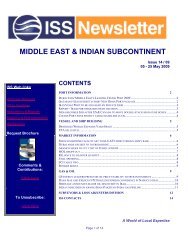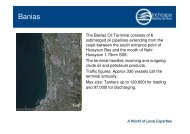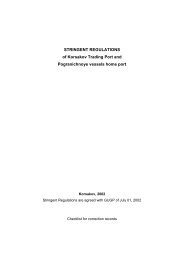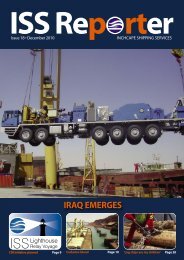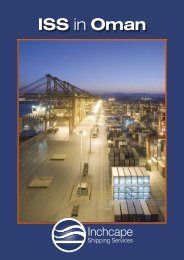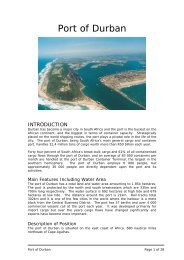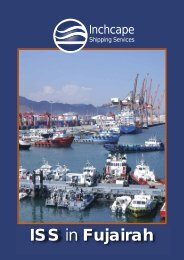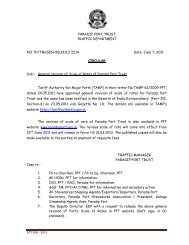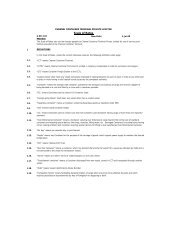Prigorodnoye Export Terminal Port Regulations.pdf - Inchcape ...
Prigorodnoye Export Terminal Port Regulations.pdf - Inchcape ...
Prigorodnoye Export Terminal Port Regulations.pdf - Inchcape ...
Create successful ePaper yourself
Turn your PDF publications into a flip-book with our unique Google optimized e-Paper software.
<strong>Prigorodnoye</strong> <strong>Export</strong> <strong>Terminal</strong> <strong>Port</strong> <strong>Regulations</strong> Rev 01<br />
15.4 Bow Loading<br />
In the ice season the hose will be connected to the bow loading valve connection. The<br />
connection arrangement will be different to the OCIMF requirements and additional<br />
preparations will be required. This will require the rigging of a pick up wire from the ship’s<br />
winch of sufficient length to be passed over the bow of the tanker and be connected to<br />
the end of the hose. The hydraulics of the ship’s loading valve should be tested, and any ice<br />
removed from the moving parts of the valve face and assembly prior to the hose being picked<br />
up.<br />
A Pusnes patent bow loading connection will be fitted by the owners of the tanker for winter<br />
operation and correct connection procedure will be advised by the Loading Master.<br />
16 TLU Berthing Approach<br />
The berthing approach at all times will be from a position against the prevailing wind and current.<br />
The Loading Master is to test the operation of the tanker engine, in ahead and astern mode, prior to<br />
making the approach to the TLU.<br />
The Loading Master will board the vessel in a position approximately 3 miles distance from the TLU -<br />
See the pilot boarding position in 5.13. The initial course is to a position where the tanker can turn<br />
towards the TLU and be down wind at one mile distance from the TLU for the final approach.<br />
17 TLU Mooring Boat<br />
The mooring boat is used for a variety of purposes during the port stay of the tanker, including<br />
terminal personnel transfer, equipment transfer, TLU preparation, hawser and hose connecting<br />
assistance, as well as oil spill response. During the ice season, mooring boat availability will be<br />
limited.<br />
18 TLU Pull Back Tug<br />
The pull back tug is able to provide a bollard pull of approximately 70 tonnes. The tugs are fitted with<br />
a bow towing reel, in addition to a stern towing bollard.<br />
The tug will be attached to the stern of the tanker once the tanker is on the approach course and<br />
approximately one mile distance from the TLU. At the time of connecting the towing line, the speed<br />
of the tanker is to be less than 3 knots, with the engine stopped to allow the connection of the tow<br />
rope. The tug will be made fast to the stern of the tanker at a distance of approximately 1 mile from<br />
the TLU. Each tanker will be required to be fitted with a ‘strong’ point at the stern to connect the tow<br />
line. This is in line with recent OCIMF recommendations. The towing line will be supplied by the tug.<br />
19 TLU Mooring Procedure<br />
The mooring boat remains in a position approximately 250 metres down current from the TLU as the<br />
tanker makes the approach.<br />
0000-S-90-01-P-0207-00-E<br />
Page 40 of 101<br />
BM Code: EP.14.03.01.09



